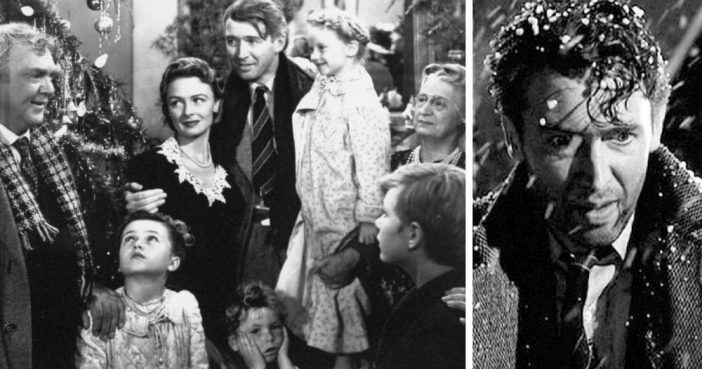
6. The Set
The movie had a budget of $3.7 million, which was hugely expensive for the mid-1940s. It took two months to construct the set on an 89-acre RKO movie ranch in Encino, California. It included 75 stores and buildings, a tree-lined center parkway with 20 fully grown oak trees and a factory district and residential areas. Main Street was 300 yards long, which was three full-length city blocks. Pigeons, cats, and dogs were allowed to roam around the set to give the town a lived-in feel. The movie was shot from April 15, 1946, and ended on July 27, 1946, which was during a heat wave. Capra had to shut down filming for a day so that the cast and crew recover from heat exhaustion.

7. Casting
James Stewart wasn’t Capra’s only choice to play George Bailey in the film. Historian Stephen Cox alleged that Henry Fonda was also in the running for the part. Stewart almost passed on the role, but Lionel Barrymore – who portrayed Mr. Potter in the film – convinced him to take the part. For the role of George’s wife Mary, Jean Arthur was first offered the role but had to turn it down because of her commitment on Broadway. Capra then offered the part to Olivia de Havilland, Martha Scott, Ann Dvorak and then Ginger Rogers. Donna Reed was then offered the part. According to her daughter, Mary Owen, Capra had seen Reed in They Was Expendable and thought she would be “just right for Mary Bailey.”

8. Behind the Scenes Drama
Two of the writers, husband, and wife Frances Goodrich and Albert Hackett, walked out because they were not happy with how they were treated by Capa. Hackett claimed that he was condescending, especially towards Goodrich. “You just didn’t address Frances as ‘my dear woman,’” Hackett said in an interview. “When we were pretty far along in the script but not done, our agent called and said, ‘Capra wants to know how soon you’ll be finished.’ Frances said, ‘We’re finished right now.’ We put our pens down and never went back to it.”

9. Polishing the Script
In 1945, RKO sold the project to Frank Capra’s production company Liberty Films for $10,000 and threw in the three scripts for free. Capra along with writers Frances Goodrich and Albert Hackett, Jo Swerling, Michael Wilson, and Dorothy Parker was brought in to “polish” the script, which was then renamed It’s a Wonderful Life. During pre-production and filming, the script underwent many revisions.

10. It Was Initially a Christmas Card
The movie is based on a story called “The Greatest Gift,” which was written by Philip Van Doren Stern in November 1939. After he failed to get the story published, he made it into a Christmas card and mailed 200 copies to friends and family in December 1943; that is when it came to the attention of producer David Hempstead. He showed it to Cary Grant’s Hollywood agent, and in 1994, RKO Pictures bought the rights to the story for $10,000 and was hoping to have Grant to star in the movie version but, after three unsatisfactory scripts, the film was shelved, and Grant went off to make another Christmas movie, The Bishop’s Wife.

Credits: fame10.com
Share this story on Facebook with your friends.
